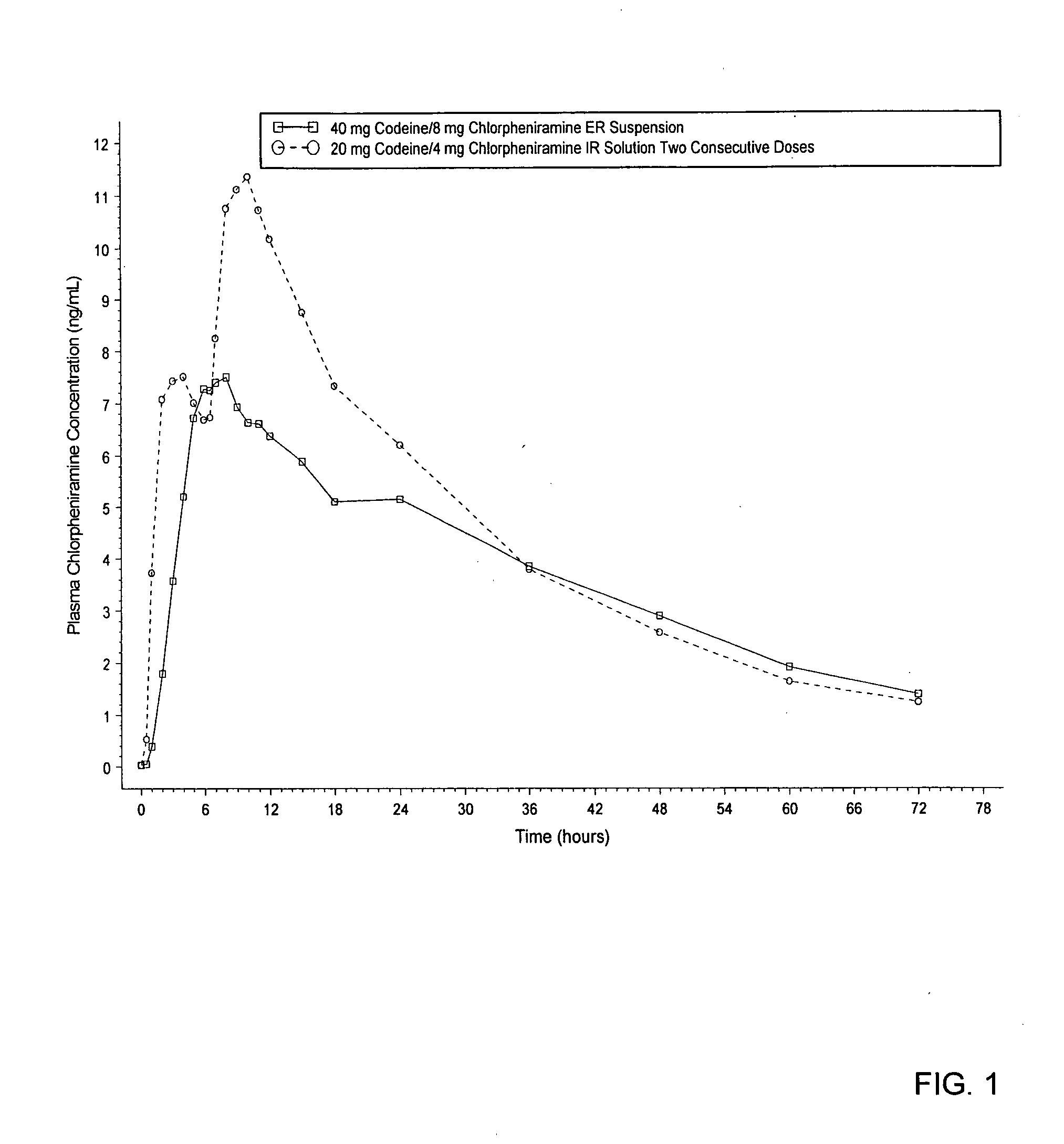Multiple active drug resin conjugate
a drug resin and conjugate technology, applied in the field of drug resin conjugate compositions, can solve the problems of affecting the rate at which the drug dissolves in the digestive system of a patient, the resin of a drug complex often will dissolve out of the complex, and the rapid dissolution of an active drug can be problematic for a patient, so as to achieve the effect of not affecting the initial availability of either active drug or the effect of retarding the initial availability of the active drug
- Summary
- Abstract
- Description
- Claims
- Application Information
AI Technical Summary
Problems solved by technology
Method used
Image
Examples
example 1
Dissolution Study of Codeine / Chloropheneramine Formulation
[0051] The release profiles for codeine / chlorpheniramine resin conjugates produced by three separate processes were studied, demonstrating that one active drug does not exchange for the other active drug. Specifically, experiments were conducted as follows: (a) codeine and chlorpheniramine were simultaneously conjugated to a single resin particle (Lot #001); (b) codeine was conjugated first to a single resin particle and then chlorpheniramine was conjugated to the codeine-resin particle (Lot #004); and (c) chlorpheniramine was first conjugated to the resin particle, with codeine subsequently conjugated to the chlorpheniramine-resin particle (Lot #007).
[0052] Sheumaker U.S. Pat. No. 4,762,709 would suggest, using the method to produce Lot #004, that some of the chlorpheniramine would displace the codeine on the resin. That is not the case with the present invention. Specifically, 16.37 percent codeine (as a percent of total ...
example 2
Biological Availability Study of Codeine / Chloropheneramine Formulation
[0054] An in vivo study was conducted using a codeine / chloropheneramine resin conjugate prepared as discussed above. FIG. 1 shows the mean chlorpheniramine plasma concentration versus time of a single dose of 10 milliliters of extended release suspension (prepared according to the method described above), including 40 milligrams of codeine and 8 milligrams of chlorpheniramine. FIG. 1 also shows the mean chlorpheniramine plasma concentration versus time of two consecutive doses (6 hours apart) of 5 milliliters of immediate release solution, with each dose including 20 milligrams of codeine and 4 milligrams of chlorpheniramine. The immediate release product was prepared by dissolving chlorpheniramine salt with polyethylene glycol and sweetener in water. The same amount of chlorpheniramine is loaded for both the extended release and immediate release products. No resin of any kind is added in the immediate release f...
example 3
[0057] Using the same codeine / chloropheneramine formulations described above, in-vitro drug release data demonstrates even, predictable dissolution profiles of the first active (codeine) and second active (chlorpheniramine), which release profiles are stable over time. Tables I and II show these results.
TABLE ICodeine Release3 M,6 M,9 M,1.5 M,3 M,6 M,Initial25 C.*25 C.25 C.40 C.40 C.40 C. 1-Hour54545454555654 3-Hour75757575777777 6-Hour8686858688888712-Hour93939394959594
*3 months aging at 25° C.
[0058]
TABLE IIChlorpheniramine Release3 M,6 M,9 M,1.5 M,3 M,6 M,Initial25 C.25 C.25 C.40 C.40 C.40 C. 1-Hour42434142414339 3-Hour65646363636562 6-Hour7877767777787612-Hour88888788879087
[0059] The dissolution testing shown in Tables I and II was conducted using a release medium of hydrochloric acid, sodium chloride, and sodium dodecylsulfate. With respect to Table I, the drug release data for codeine shows even, predictable results, for example, at the initial testing, 54 percent dissolutio...
PUM
| Property | Measurement | Unit |
|---|---|---|
| temperature | aaaaa | aaaaa |
| size | aaaaa | aaaaa |
| temperature | aaaaa | aaaaa |
Abstract
Description
Claims
Application Information
 Login to View More
Login to View More - R&D
- Intellectual Property
- Life Sciences
- Materials
- Tech Scout
- Unparalleled Data Quality
- Higher Quality Content
- 60% Fewer Hallucinations
Browse by: Latest US Patents, China's latest patents, Technical Efficacy Thesaurus, Application Domain, Technology Topic, Popular Technical Reports.
© 2025 PatSnap. All rights reserved.Legal|Privacy policy|Modern Slavery Act Transparency Statement|Sitemap|About US| Contact US: help@patsnap.com


